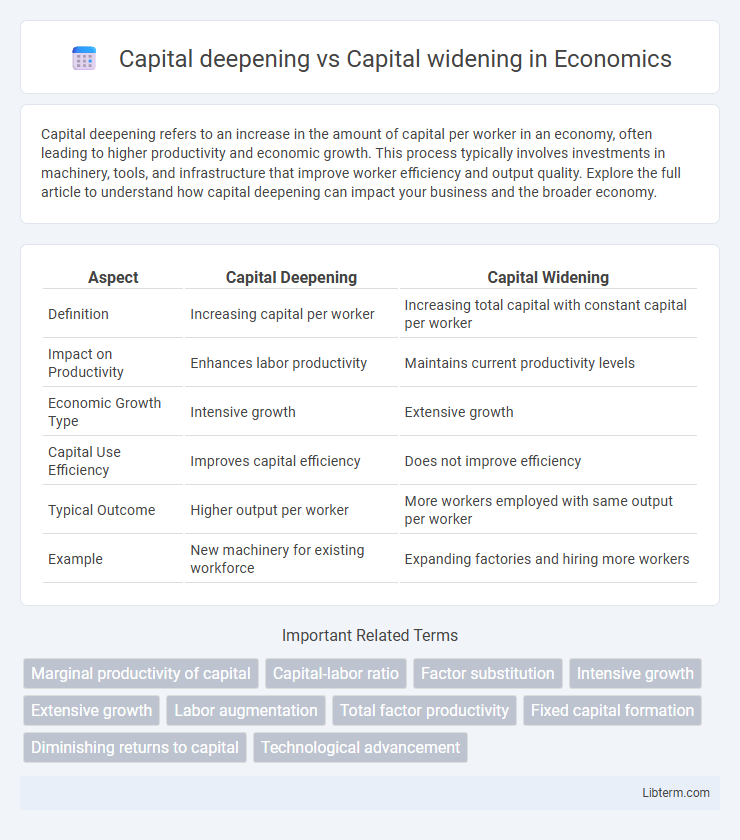Capital deepening refers to an increase in the amount of capital per worker in an economy, often leading to higher productivity and economic growth. This process typically involves investments in machinery, tools, and infrastructure that improve worker efficiency and output quality. Explore the full article to understand how capital deepening can impact your business and the broader economy.
Table of Comparison
| Aspect | Capital Deepening | Capital Widening |
|---|---|---|
| Definition | Increasing capital per worker | Increasing total capital with constant capital per worker |
| Impact on Productivity | Enhances labor productivity | Maintains current productivity levels |
| Economic Growth Type | Intensive growth | Extensive growth |
| Capital Use Efficiency | Improves capital efficiency | Does not improve efficiency |
| Typical Outcome | Higher output per worker | More workers employed with same output per worker |
| Example | New machinery for existing workforce | Expanding factories and hiring more workers |
Introduction to Capital Deepening and Capital Widening
Capital deepening refers to an increase in the amount of capital per worker, enhancing labor productivity through better tools, machinery, and technology. Capital widening involves expanding the total capital stock to equip a growing workforce, maintaining the capital-to-labor ratio but increasing overall production capacity. Understanding these concepts is essential for analyzing economic growth patterns and the efficiency of resource allocation in an economy.
Defining Capital Deepening
Capital deepening refers to the process of increasing the amount of capital per worker, enhancing labor productivity by providing more or better-quality tools, machinery, and infrastructure. It contrasts with capital widening, which involves expanding capital supply in proportion to labor growth, maintaining the existing capital-to-labor ratio. In economic growth models, capital deepening is a critical driver of increased output per worker and long-term improvements in living standards.
Defining Capital Widening
Capital widening refers to an increase in the capital stock that expands the workforce by providing more capital per worker but maintains the existing capital-to-labor ratio. It contrasts with capital deepening, which increases capital intensity by raising the capital per worker ratio, leading to productivity improvements. Understanding capital widening is essential for analyzing economic growth driven by labor force expansion without changes in capital efficiency.
Key Differences Between Capital Deepening and Capital Widening
Capital deepening involves increasing the capital per worker, enhancing labor productivity through better equipment or technology, while capital widening expands total capital to maintain the capital-to-labor ratio as the workforce grows. Key differences include that capital deepening raises capital intensity leading to higher output per worker, whereas capital widening keeps output per worker constant by scaling capital resources with the labor force. Economies pursuing capital deepening experience technological advancement and growth in labor efficiency, contrasting with capital widening which focuses on sustaining current productivity levels amid workforce expansion.
Economic Impacts of Capital Deepening
Capital deepening, characterized by an increase in capital per worker, enhances labor productivity and drives sustainable economic growth by enabling more efficient production processes. This intensification of capital investment often leads to higher wages, improved living standards, and accelerated technological adoption within an economy. In contrast to capital widening, which expands the labor force without necessarily improving productivity, capital deepening directly boosts output per worker, fueling long-term economic development and competitiveness.
Economic Impacts of Capital Widening
Capital widening expands the total stock of capital by increasing the number of workers equipped with existing capital, leading to proportional growth in output without changing capital intensity per worker. This approach sustains economic growth by maintaining labor and capital ratios, which prevents diminishing returns and supports stable productivity levels. Capital widening's economic impacts include steady employment growth, consistent wage levels, and prevention of capital dilution in the workforce.
Capital Deepening and Productivity Growth
Capital deepening involves increasing the amount of capital per worker, which directly boosts labor productivity by enabling workers to utilize more or better-quality tools and technology. This process enhances total factor productivity as workers become more efficient with advanced machinery and improved infrastructure. Sustained capital deepening is a key driver of long-term economic growth, as higher capital intensity leads to greater output per worker and improved standards of living.
Labor Force Implications in Capital Widening
Capital widening involves increasing the labor force alongside capital investments, maintaining the existing capital-to-labor ratio, which allows economies to expand output proportionally with workforce growth. This approach primarily supports employment growth by integrating more workers into the production process without enhancing individual labor productivity. Unlike capital deepening, which raises capital per worker to boost efficiency, capital widening emphasizes scaling up resources to accommodate a larger labor force, addressing demographic changes and labor supply increases.
Real-World Examples of Capital Deepening and Widening
Capital deepening involves increasing the amount of capital per worker, boosting productivity and economic growth; for instance, South Korea's investment in advanced machinery and technology during the 1980s accelerated its industrial output. Capital widening refers to expanding the workforce with additional capital to maintain the capital-to-labor ratio, illustrated by India's large-scale infrastructure projects and workforce expansion supporting its growing population. Real-world examples highlight how Germany's focus on advanced manufacturing technologies exemplifies capital deepening, while China's rapid urbanization and factory construction represent capital widening strategies driving economic development.
Policy Considerations and Future Trends
Capital deepening enhances labor productivity by increasing capital per worker, requiring policies that support investment in technology and skills development. Capital widening expands the labor force through population growth or immigration, demanding infrastructure development and labor market integration strategies. Future trends emphasize balancing both approaches, integrating digital innovation and inclusive workforce policies to sustain economic growth.
Capital deepening Infographic

 libterm.com
libterm.com